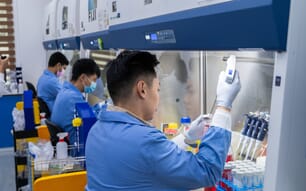Since 2011 there has been ban on fishing for eel in most Dutch inland waters. The sediment in the watershed of the Maas and the Rhine in particular is too polluted with dioxins and PCBs (polychlorobiphenyls). Eels from these waters exceed the levels considered safe by a big margin.
Van den Dungen’s research among 80 regular eel eaters – most of them fishers or traders – shows that the fishing ban is more than justified. These men eat at least 150 grams of eel per month and some of them had eaten eel from the polluted areas.
Those who had eaten ‘polluted eel’ turned out to have 2.5 times more dioxin-like substances in their bodies than those who had eaten ‘clean eel’. Levels of PCBs and hormone-disrupting PCB metabolites were up to 10 times higher. Both levels were far higher than the levels assumed to be safe. "I was particularly shocked by the PCB levels," says Van den Dungen.
DNA-methylation
She also studied effects on the DNA of the eel eaters. One of these is methylation, a phenomenon that has been linked with various diseases. She found methylation in various genes that were implicated in cancer and the functioning of the immune system. According to Van den Dungen, this suggests that the pollution may have an effect on health.
There is no cause for alarm, however, according to the toxicologist. These diseases were brought to light by basic health tests.
"The safe levels are geared to protecting the most vulnerable people: mothers and their unborn babies. That does not mean, however, that there is no effect on health. More subtle negative health effects cannot be ruled out, on the basis of our results, and on the basis of the literature one might even expect them."
Van den Dungen’s advice is clear, then: do not eat eel from the regions where the fishing ban is in force. Of all the eel sold in the Netherlands, 95 per cent comes from fish farms. It is not known how much eel caught by amateur fishers is eaten.




